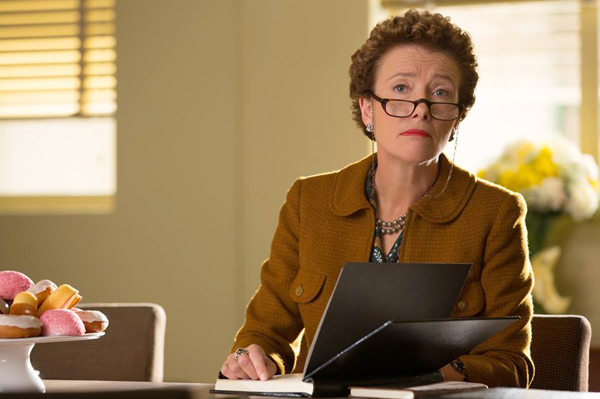Poor Mary Poppins, both the character and the 1964 musical film produced by Walt Disney. Over the years, the two have become shorthand for schmaltz, but that’s not accurate. Though this Broadway-style musical is G-rated wholesome, its central force, Mary Poppins, is as blunt and standoffish as she is in the books by author P. L. Travers, first published in the 1930s.
Maybe the film’s reputation is due to the dancing penguins, the two precocious child actors playing the Banks children, the upbeat melodies, or the success of The Sound of Music. Released less than a year after Poppins, that musical was sugary where Poppins is tart. Poppins, on the film and on the page, is not very warm and fuzzy. She boasts that she’s practically perfect in every way and won’t let anyone forget it. On the page, she comes across as brittle, but as played by Julie Andrews, she’s firm and tough loving.
The biopic Saving Mr. Banks half-heartedly corrects this misconception in this comedic culture clash of two mind-sets: the blunt Brit (though technically Australian-born) Travers, played by Emma Thompson, defies the homespun Hollywood movie mogul Disney (Tom Hanks). Since the 1940s, she has refused to grant the producer the film rights to her imperious and unpredictable governess. Now in 1961, she travels first-class (paid for by American lucre) to Los Angeles to scrutinize the film project in preproduction before she grants her consent, and she yields script approval like a lethal weapon. Inflexible, judgmental, and cuttingly condescending, she’s the ugly Brit, if there were such a term. The last thing Travers wants is a screenplay stuffed with “whimsy and sentiment” and “certainly not a musical.” Her Poppins faces the hard truths of life, though through magic. At her core, Poppins refrains from sentimentality. The same can’t be said for this film.
Banks, a coproduction between the BBC Films and the current Disney regime, acknowledges that though exacting, Travers doesn’t completely get her way, but she’s not flattened by studio machinations either. Even a hard negotiator like Travers is not resistant to the charms of Disney’s version of her tales, especially the buoyant score by Richard and Robert Sherman (played by Jason Schwartzman and B. J. Novak, respectively). Though her stories were originally set in the 1930s, Disney blew them back into the Edwardian era, and the composers combined pre-Beatles pop with catchy English music hall ditties, which helped to lure Andrews to the project; she began her stage career as a child prodigy with a multiple octave voice during the waning days of the music hall. And in this telling, Travers isn’t impervious to Mickey Mouse, snuggling up to the giant stuffed rodent during a rough, sleepless night.
Most likely, Travers would find this screen version of her life to be obvious and heavy handed. The frequent and none too subtle flashbacks shift the focus to her downscale childhood in the boonies of Australia, obviously filmed in California, with an emotionally wrecked mother and a dad who takes to the bottle. Besides heartbreak, Pa gives his daughter the gift of spinning a tale.
There’s no mystery about Travers’s background, unlike the origins of Mary Poppins; here, the author’s backstory even includes the genesis for Poppins: an aunt who comes to the aid of the destitute family. Played by Rachel Griffiths, she totes a carpet bag and an umbrella with a parrot’s head and spouts dialogue out of the Disney version—as if another tie-in to that film were necessary. (The 50th anniversary edition of Poppins has also just been released.} Unglamorous here, Griffiths probably would have received Travers’s seal of approval; the author thought Andrews was too pretty for Poppins but had the right nose for the character. Griffiths more closely resembles the nanny from the original illustrations by Mary Shepard.
Despite the armchair psychoanalysis, it takes a flinty heart to resist the power of the ending of Banks, which mirrors the bittersweet finale of Poppins. The cast sings the rousing “Let’s Go Fly a Kite,” but melancholia hovers in the air: Mary Poppins, lead by her umbrella, flies away, leaving behind the Banks family. (Just seeing snippets of the Disney film will make millions of baby boomers teary eyed.) Viewing Mary Poppins beforehand certainly adds a needed resonance, but why would Mr. Banks appeal to anyone who hasn’t first seen the Disney film?
Though a Broadway-style, live-action, irony- and cynic-free movie musical like Mary Poppins has long been out of style, that film holds up very well, even though its pace would be considered slow today. Years ago, I was at a bookstore finding refuge during a heat wave, and the film was playing to a broad representation of kids of the Upper West Side, all sitting glued in front of the TV screen—the prim and proper nanny still commands attention. Travers need not have worried about Disney turning Poppins into one of his “silly cartoons,” As played by Andrews, Mary Poppins was in good hands. Andrews is nothing if not sincere; anyone would believe she could fly. It’s highly doubtful that without her performance—or the mix of live-action and animation—Travers’s beloved nanny would be as well remembered today.







Leave A Comment